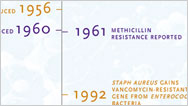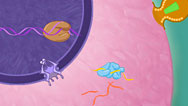Making Vaccines
- By Rick Groleau
- Posted 11.13.01
- NOVA
Vaccines work by generating an immune response in the body against some kind of pathogen—a virus, bacterium, or some other agent that causes a disease. A vaccine exposes the immune system to a less-threatening version of the pathogen and, in effect, primes it to recognize and quickly eliminate a more dangerous version should it ever invade the body. Here, see how various kinds of vaccines are made.
 Launch Interactive
Printable Version
Launch Interactive
Printable Version
How are vaccines made? Create six vaccines in our virtual laboratory, using a different technique to produce each one.
This feature appeared on the site for the NOVA program Killer Disease on Campus.
Credits
Illustrations
- (all)
- © WGBH/NOVA
Related Links
-

Vaccines—Calling the Shots
Examine the science behind vaccinations, the return of preventable diseases, and the risks of opting out.
-

Arms Race With a Superbug
Certain microbes evolve defenses against every antibiotic we throw at them. Staph aureus is a sobering case in point.
-

Let's Make a Microbe!
Find out what separates life from nonlife, and glimpse how scientists are exploring the boundary.
-

RNAi Explained
What is RNAi and how does it work? We'll show you using cartoon metaphors as well as standard scientific terms.
You need the Flash Player plug-in to view this content.

